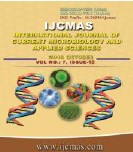


 National Academy of Agricultural Sciences (NAAS)
National Academy of Agricultural Sciences (NAAS)

|
PRINT ISSN : 2319-7692
Online ISSN : 2319-7706 Issues : 12 per year Publisher : Excellent Publishers Email : editorijcmas@gmail.com / submit@ijcmas.com Editor-in-chief: Dr.M.Prakash Index Copernicus ICV 2018: 95.39 NAAS RATING 2020: 5.38 |
The advent of HAART has been associated with a profound reduction in morbidity and mortality from HIV/AIDS. However, side effects and toxicities associated with HAART may lead to an increased risk for cardiovascular diseases. The aim of this study was to determine the prevalence of dyslipidemia and determining factors of derangements in lipid profile associated with use of HAART regimens in people living with HIV/AIDS. This cross-sectional study was carried out from October 2012 to April 2014. Patients aged above 18 years, who were newly started on first line antiretroviral therapy were included in this study. Lipid profile was determined after overnight fast and dyslipidemia was diagnosed according to US National Cholesterol Education Program criteria. Socio-demographic characteristics were also collected using a questionnaire. Data was analyzed using STATA; chi-square test, t-test, ANOVA and logistic regression were computed. Significant change in LDL level was noted in patients on follow up. Trend of increasing T.C. level was noted on follow up among patients on ART. Patient on ZLN ART regimen had significant changes in HDL, LDL, TC, and TG favoring dyslipidemia. Similar changes were also noted in patients on ZLE. It was observed that patients having trend towards dyslipidemia also had improving CD4 counts. We can conclude that dyslipidemia among HIV-infected patients using HAART are significantly associated with longer duration of treatment. Lipid profile and other cardiovascular risk factors should be monitored in patients on ART so that any negative effects of HAART can be optimally managed.
 |
 |
 |
 |
 |